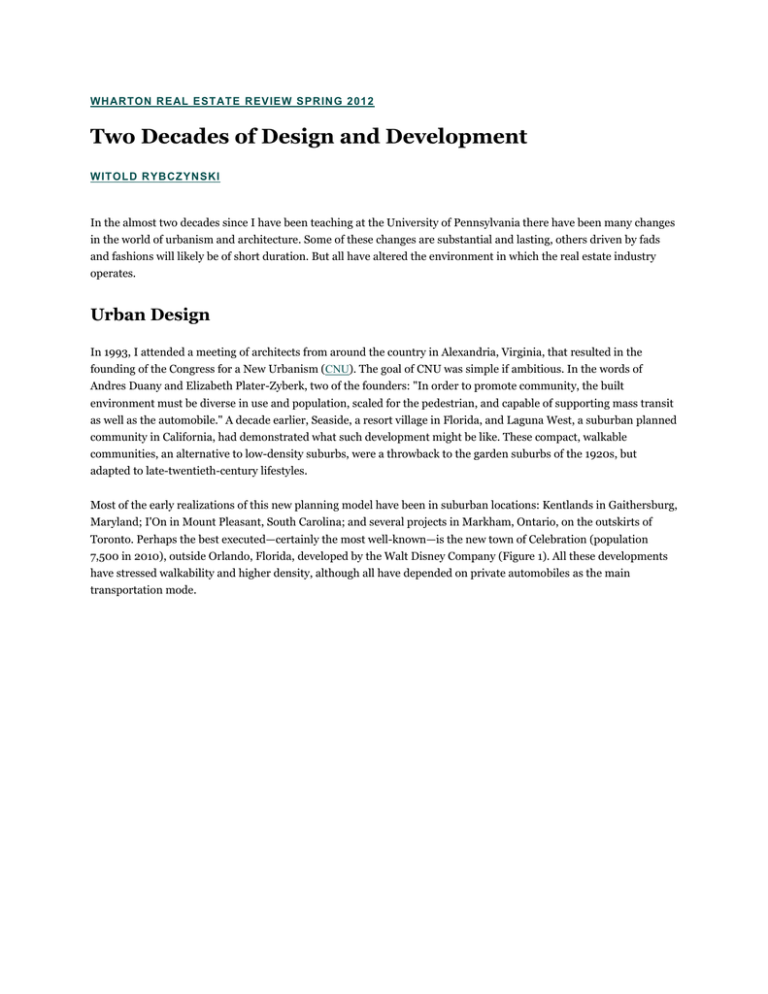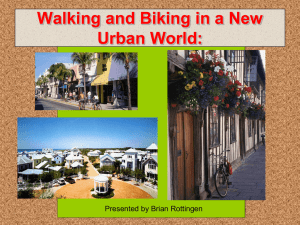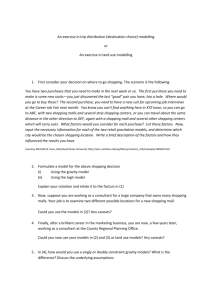Two Decades of Design and Development
advertisement

WHARTON REAL ESTATE REVIEW SPRING 2012 Two Decades of Design and Development WITOLD RYBCZYNSKI In the almost two decades since I have been teaching at the University of Pennsylvania there have been many changes in the world of urbanism and architecture. Some of these changes are substantial and lasting, others driven by fads and fashions will likely be of short duration. But all have altered the environment in which the real estate industry operates. Urban Design In 1993, I attended a meeting of architects from around the country in Alexandria, Virginia, that resulted in the founding of the Congress for a New Urbanism (CNU). The goal of CNU was simple if ambitious. In the words of Andres Duany and Elizabeth Plater-Zyberk, two of the founders: "In order to promote community, the built environment must be diverse in use and population, scaled for the pedestrian, and capable of supporting mass transit as well as the automobile." A decade earlier, Seaside, a resort village in Florida, and Laguna West, a suburban planned community in California, had demonstrated what such development might be like. These compact, walkable communities, an alternative to low-density suburbs, were a throwback to the garden suburbs of the 1920s, but adapted to late-twentieth-century lifestyles. Most of the early realizations of this new planning model have been in suburban locations: Kentlands in Gaithersburg, Maryland; I'On in Mount Pleasant, South Carolina; and several projects in Markham, Ontario, on the outskirts of Toronto. Perhaps the best executed—certainly the most well-known—is the new town of Celebration (population 7,500 in 2010), outside Orlando, Florida, developed by the Walt Disney Company (Figure 1). All these developments have stressed walkability and higher density, although all have depended on private automobiles as the main transportation mode. Figure 1: Residential street, Celebration, Fla. The emergence of new urbanism during a major housing boom is no coincidence. The boom created conditions for a new concept to take root. Not only was demand for housing so strong that any project had a chance of success, but also it opened the door to neophyte developers and lenders who were willing to try new and unproven communityplanning models. Without exception, the early developers of new urbanism projects were small, relatively inexperienced firms, and it was only after new urbanism proved itself in the marketplace that large firms such as Disney and ForestCity embraced the concept. With the arrival of larger developers, new urbanist ideas appeared in urban locations such as Stapleton in Denver and Atlantic Stationin Atlanta. New urbanism has also had a significant impact on the inner city in the form of the Hope VI program, which was enacted into federal law in 1998. Hope VI projects replaced 1950s urban renewal-era public housing projects with mixed social/market housing designed according to new urbanist principles. To date, 170,000 units of Hope VI housing have been built. The successes of the new urbanist movement do not mean that the public has wholeheartedly embraced neotraditional urban design, judging from another watershed event that occurred in 2002 at the Javits Convention Center in New York. This public forum was organized to consider alternative schemes for the reconstruction of the World Trade Center site in the wake of the September 11 terrorist attacks. Six alternatives were presented and conclusively rejected by the participants. What made the rejection historically important was that the schemes, which were prepared by a variety of respected urban design firms—Beyer Blinder Belle, Cooper Robertson (Figure 2), Skidmore Owings & Merrill, and Peterson Littenberg—were all based on neotraditional urban design principles: streets, blocks, parks, piecemeal development, individual buildings. But the public, incited by editorials in the New York Times, wanted exciting architecture. Weaned on a regular diet of increasingly spectacular new museums, public libraries, and concert halls, the public demanded that the redevelopment of the World Trade Center site should be out of the ordinary. Figure 2: Early study of WTC site, Cooper Robertson & Partners. The resulting international competition presented just that, with finalists Norman Foster, Richard Meier, Foreign Office Architects of London, and UNStudio of Amsterdam, proposing unusual skyscrapers and high-rise complexes. highly publicized run-off was between Studio Daniel Libeskind and a team headed by Rafael Vinoly, with Libeskind declared the winner. However, the design that seemed so compelling in the immediate aftermath of 9/11 did not weather the extended review process and the economic realities of development. In the decade that followed, virtually every one of the winning scheme's "exciting" ideas was abandoned, and other architects were appointed to design the 9/11 memorial(Michael Arad and Peter Walker), the museum pavilion (Snohetta of Oslo), and four office towers (SOM, Foster + Partners, Rogers Stirk Harbour, and Fumihiko Maki). Oddly enough, the final result, which will not be complete for another decade, seems likely to be a vindication of the urban design ideas presented at the Javits Center. Developers Shape The City Many of the changes in the World Trade Center architectural lineup were the result of demands made by the site's developer, Larry Silverstein. This situation reflects a new reality of the last few decades: real estate developers have replaced city planners as the chief decision-makers in urban development. This has happened in part because city planning is still held in low repute following the dramatic urban renewal failures of the 1950s and 1960s, from which many American cities are only just recovering. But the real estate industry has also changed. Firms are larger, more professional, and with the advent of publicly owned real estate firms have greater access to capital, putting them in a position to undertake large and lengthy urban development projects such as Atlantic Station in Atlanta, Stapleton in Denver, The Yards in Washington, D.C., and Atlantic Yards in Brooklyn. Developers are better than public agencies at figuring out what people want and how to deliver it. But the shift from public to private planning is not an unalloyed good. The concerns of the developer naturally tend to be restricted to his project, rather than to the larger context. As a result, links to the surrounding city are often weak, connections to other developments nonexistent, and transportation infrastructure lacking. The developer does not have the incentive or, indeed, the tools, to deal with these larger issues. Thus suburban projects, for example, tend to develop autonomously, rather than forming a larger regional pattern. The solution lies in private-public collaboration, and indeed the development projects that are most successfully integrated with their surrounding contexts tend to be those executed with a private-public partnership, with the public body filling in those areas that private development finds difficult or impossible to undertake. Mixed-Use The pace of change in the design of retail sites has accelerated in the last two decades. Large indoor shopping malls, which were for long the model for organizing retail, even in urban areas, have faltered. While the Class A malls in the best locations have maintained their market positions, the construction of new malls has ceased, and many older malls have been shuttered. A number of factors has caused the change: the decline in the fortunes of many department stores, which traditionally were the key ingredient in the shopping mall model; changes in shopping patterns, favoring convenience and brevity over a more leisurely shopping experience (remember when malls were conceived of as "entertainment centers"?); competition from big-box discount retailers, especially Wal-Mart; and to a lesser extent, the gradual shift to on-line shopping and entertainment. The end of new mall construction has not signaled the end of retailing. The two suburban shopping formats that have replaced the regional mall are at opposite ends of the spectrum. At the basic end is the no-nonsense power center, consisting of big-box discount stores surrounding a parking lot. Responding to shoppers' demands for low prices and convenience, power centers are less expensive to build and manage than indoor malls. At the other end is the socalled lifestyle center: an outdoor Main Street arrangement that dispenses with the (expensive) indoor concourses of traditional malls, and combines stores and restaurants with other uses such as residential, hotel, and offices. The largest and densest example of a lifestyle center is Reston Town Center, in Reston, Virginia, but smaller projects abound: Rockville Town Square in Rockville Maryland, Atlantic Station in Atlanta, City Place in West Palm Beach, and Universal CityWalk in Hollywood. Somewhere between these two extremes is the festival marketplace, which has proved successful in urban locations with the right characteristics, that is, an interesting architectural context, an attractive waterfront, active tourism, and surrounding high-density, upper-income residential neighborhoods. Figure 3: Retail below, housing above. Reston Town Center, Reston, Virginia Mixed-use has become a mantra for some developers, who tout the advantages of a "24-hour place" and of spreading risk among several different market sectors (retail, housing, offices), and the cost advantage of operating what amounts to a "topless mall." And the public has responded favorably to these outdoor shopping places (as they did to enclosed shopping malls in the 1950s). But mixed-use developments are more complicated to design, build, and manage than traditional malls, and they require a special skill set on the part of the developer. "Mixed-use" does not mean indiscriminately combining different functions. Singles or student housing can be combined with late-night entertainment districts, but not family or senior housing. Shoppers expect to see local retailers, not only familiar national chains. And design quality, which has traditionally been less important in shopping mall design, is a crucial factor. One of the best designed mixed-use centers is the town center of Celebration, Florida, which was the result of a collaboration between a far-sighted (and wealthy) client—the Disney Company—and two talented design architects, Robert A. M. Stern and Jaquelin T. Robertson. But, as many developers have discovered, mixed-use should not be undertaken lightly. Leading retail developer, Hap Stein, warned in the Spring 2011 issue of the Wharton Real Estate Review: "Don't develop lifestyle projects, period, or mixed-use developments, which can be even more complicated than community centers, without a partner possessing substantial office or apartment expertise and deep pockets." Future Challanges The challenges of the next two decades include not only developing successful models of mixed-use, but something even more complicated: increasing housing density. The issue of density is different in urban areas and in suburbs. Assuming that energy prices will eventually rise, and that government regulations on carbon emissions will come into effect in some fashion, energy conservation will become a paramount concern. Mass transit and walkable communities can only function successfully with high urban densities—higher than current levels in most downtowns, with the exception of a handful: New York, Chicago, Boston, San Francisco, Philadelphia. To date, dense urban living has attracted only two market segments: childless young professionals and retirees. New urbanism has not embraced high-rise, high density solutions, and it remains to be seen whether the movement will expand in this direction. What some have called the Vancouver model—extremely slim residential high-rises sitting on bases consisting of townhouses—may be an attractive solution for some cities (Figure 4). In locations where the view is not a paramount consideration, low-rise/high-density solutions may be more appropriate—and less expensive. As Alan Ehrenhalt observes in his forthcoming book, The Great Inversion, there is mounting evidence that a significant portion of the millennial generation is attracted to urban living, as either tenants or owners. While the urban housing of the 20002008 period was aimed at buyers with relatively high incomes, the challenge of the second round of urban housing construction will be to develop housing that is be more affordable and more family-friendly. Figure 4: Vancouver, the new model? There are many different models for dense urban living: New York, London, Singapore, Vancouver, but fewer examples of how to densify American suburbs. Once the housing industry revives—whenever that happens—the demand for far-out, exurban locations will likely be permanently reduced. The cause for this will be higher gasoline prices and a generally more conservative approach to housing risk in the wake of the recent housing collapse. It is unlikely that many homeowners' preferences for single-family houses and suburban lifestyles will drastically change, and a large part of the market will continue to prefer this type of housing, although perhaps somewhat smaller than during the last housing boom. The question is where will these smaller houses be built? Initially, new houses can occupy infill or replacement parcels in existing suburban communities, on the periphery of central city districts. The over-construction of retail space in the last several decades means that the sites of shuttered malls will also be prime candidates for redevelopment. But at some point the delicate issue of raising densities will have to be broached. Suburban densification will require that communities revise existing zoning regulations in order to allow taller buildings, lot subdivision, mixed uses, and multi-family housing. Given the historical resistance to change and especially to any measure that even slightly increases housing density (and traffic), this will be a tall order. But altering long-held attitudes and prejudices will affect not only housing patterns, but also the degree to which national environmental policies can succeed. Copyright 2012 Witold Rybczynski.



